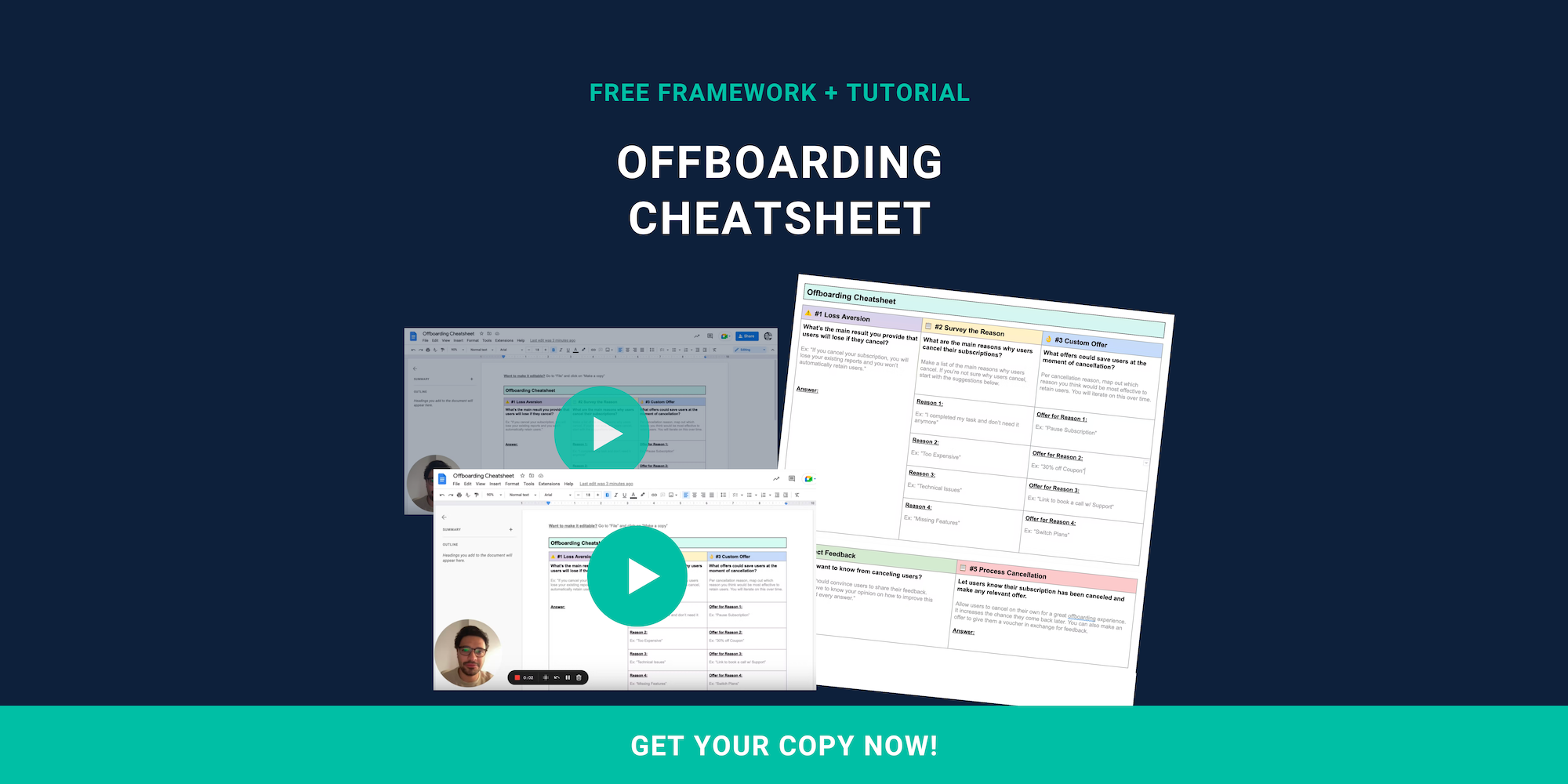As you enter the market with your SaaS solution, a product launch plan will enable you to hit the ground running. When you launch a SaaS product, it’s likely you will go head-to-head with more established and better-funded competitors. If you don’t have a robust launch plan in place, your SaaS may struggle to make a big splash and gain traction in the market.
Understanding the bigger picture and how you fit into the broader market is crucial to crafting an effective SaaS product launch plan. While it’s important to respond to changing circumstances and market environments, you shouldn’t make your launch up as you go along. This is a recipe for disaster. It’s essential for SaaS founders to do the groundwork and develop a launch plan.
Raaft can play a pivotal role in collecting feedback from early adopters and saving customers with retention flows. Even though you’re just getting started with your SaaS, you don’t want to be losing your early adopters. It’s vital to implement customer retention strategies from the outset. Our solution is designed to reduce SaaS churn with customer feedback and intelligent detours.
Product Launch Plan Checklist (4 Steps)
According to data from SaaS Capital, a $2 million SaaS company must be growing more than 90% year-over-year to be in the top 25% of its peers. To compete in the SaaS world, you must go in with a clear product launch plan.
Step 1 - Know your competitors
A solid understanding of the competitive landscape will increase your self-awareness as a SaaS founder. Unless you’re working on a SaaS product that’s truly disruptive and game-changing, you’re going to run into competitors. It’s better to figure out who these people are before your launch. By doing this, you can shift and alter your brand positioning and messaging accordingly.
You can begin by asking beta or prospective customers whether they have tried or considered any alternative solutions on the market. You could also delve a little deeper and ask about their experiences with alternative solutions. This should start to build a picture of how your target market perceives the competitors and why their solutions are failing to corner the market.
SaaS companies may have more funds than you - but this doesn’t mean their product is better. When existing products on the market are lacking product-market fit, you have an opportunity to exploit unrecognized simplicities. While you shouldn’t obsess too heavily over your competitors, being aware of their presence and knowing how they fit into the broader market is crucial.
Step 2 - Focus on delivering value
As a SaaS founder, your mind should be entirely focused on value creation. When customers sign up for your SaaS solution, how can you ensure they unlock as much value as possible? Ultimately, value is measured by how effective your product is at addressing a pain point. If customers cannot unlock value from your product, churn is likely to be high.
Narrowly defining your target market will enable you to focus on specific value creation. This is a key advantage of niching down. Value creation revolves around successfully addressing customer needs and meeting pain points. Product-market fit can only be achieved by providing customers with an adequate solution to a problem they’re trying to solve.
To ensure you have product-market fit, you should conduct interviews with customers and ask the following questions:
- How frustrated would you be if you couldn’t use the product anymore?
- What pain point does the product address and solve?
- How likely are you to continue using the product?
- What do you dislike about the product?
- Why are you using the product as opposed to other solutions?
- What do you love about the product?
- What could make your experience better?
Naturally, as you launch your product, you will learn more about product-market fit. If you’re serious about your product launch and want to make it a success, you must conduct extensive user research before moving forward with your launch. This will ensure you have a strong product-market fit. There’s nothing worse than launching a product without a clear market.
Step 3 - Generate traction strategically
To quickly gain traction, you should leverage a range of customer acquisition channels. Rather than narrowing in on a single channel, you should aim to focus on a handful of channels as part of the product launch plan. Upon measuring your results, you can optimize your growth efforts around a particular customer acquisition channel that is proving to generate results.
There’s no shortage of customer acquisition channels - but you shouldn’t leverage all of them. By spreading yourself too thin, you run the risk of making little progress on any channel. It’s better to optimize and refine your efforts on a handful of channels at a time. Here are just a few examples of customer acquisition channels that could be featured in your product launch plan:
- SEO (Search Engine Optimization)
- Pay-Per-Click (PPC)
- Email Outreach
- LinkedIn Organic Reach
- Facebook Groups
- Cold Calling
- Trade Shows
- Live Events
- Print Ads
- TV & Radio
Step 4 - Track performance metrics from the outset
Before launching your product, you need to have the systems in place to track key metrics. Growth metrics are fundamental to making informed decisions. It’s likely that you will learn plenty from your initial product launch. Key SaaS metrics will help you to see a well-rounded picture of your performance. Here are some of the SaaS metrics you should be tracking:
- Customer Churn
- Revenue Churn
- Customer Lifetime Value
- Customer Acquisition Cost
- Months to Recover CAC
- CAC:LTV Ratio
- Qualified Marketing Traffic
- Leads by Lifecycle Stage
- Lead-to-Customer Rate
- Customer Engagement Score
- Customer Health Score
How do I launch my SaaS product?
Before you launch your SaaS product, you must determine whether you have a solution that effectively meets a need. To do this, you should consider using the Jobs-to-be-done (JTBD) framework. We would also recommend answering the following questions:
- What problem does the product resolve?
- Why will your target market buy the product?
- Does your product have a market niche?
- Who are your competitors and what are their advantages?
We hope this guide has provided you with ideas for your product launch plan.
As you implement your product launch plan, you should get the right systems in place to prevent churn and drive customer retention. Try Raaft for free today.

Offboarding Cheatsheet
This framework + video tutorial will help you design a better cancellation process.
Some of our featured articles

Miguel Marques

Adam Crookes

Adam Crookes
Customer Success insights in your inbox
Helping Founders and Customer Success Managers handle customer retention effectively.
We will only ever send you relevant content. Unsubscribe anytime.


